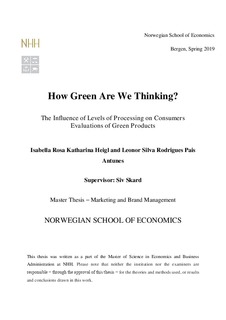| dc.description.abstract | As a result of a growing wave of more environmental awareness and a rise in environmental concerns, companies have started to incorporate green marketing strategies to meet consumers demands and expectations for sustainable products.
Nevertheless, despite this rising interest in environmentally friendly products, many sustainable products struggle to receive commercial success. Consequently, in the past decades, an increasing body of research has started to explore this inconsistency between green attitudes and purchasing behavior. It is still unclear, however, why it occurs, and which factors play a major role in the decision-making process. We explore how perceptions of functional quality can act as a potential barrier to green consumerism. Building on theories of attribute centrality, we study how products with central and peripheral green attributes are evaluated in contrast to a baseline, non-green alternative product in a strong product category. Further, we study the relationship between level of processing and consumers evaluations.
By means of a field experiment, we find from the main effects that consumers seem to choose the different alternatives equally, as no significant differences were found on choice neither when contrasting green vs. non-green nor when considering attribute centrality, in the strong product category. For this category, we find that there is a trade-off between sustainability and quality, as the green alternatives are perceived to have lower functional quality. Interestingly, a higher market success is nonetheless anticipated for these alternatives. Further, this trade-off seems to occur, irrespective of the cognitive information processing system. However, the cognitive enhancement manipulation reveals a significant positive effect on choice, with the green central alternative appearing as the preferred product. Under this manipulation, the green central alternative is, as well, ranked at the top when it comes to anticipated market success. Therefore, when system 2 is activated, eco-friendliness can increase product preference, although this might be perceived by consumers to have inferior functional quality. | nb_NO |
